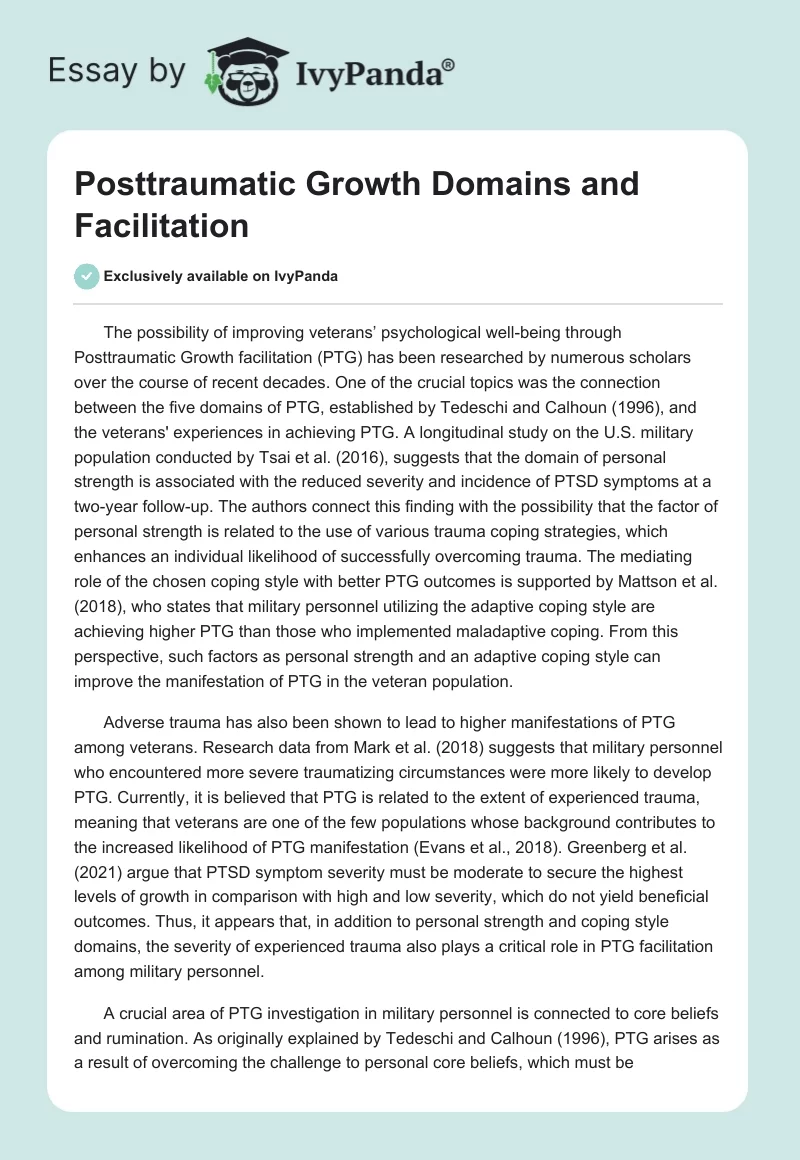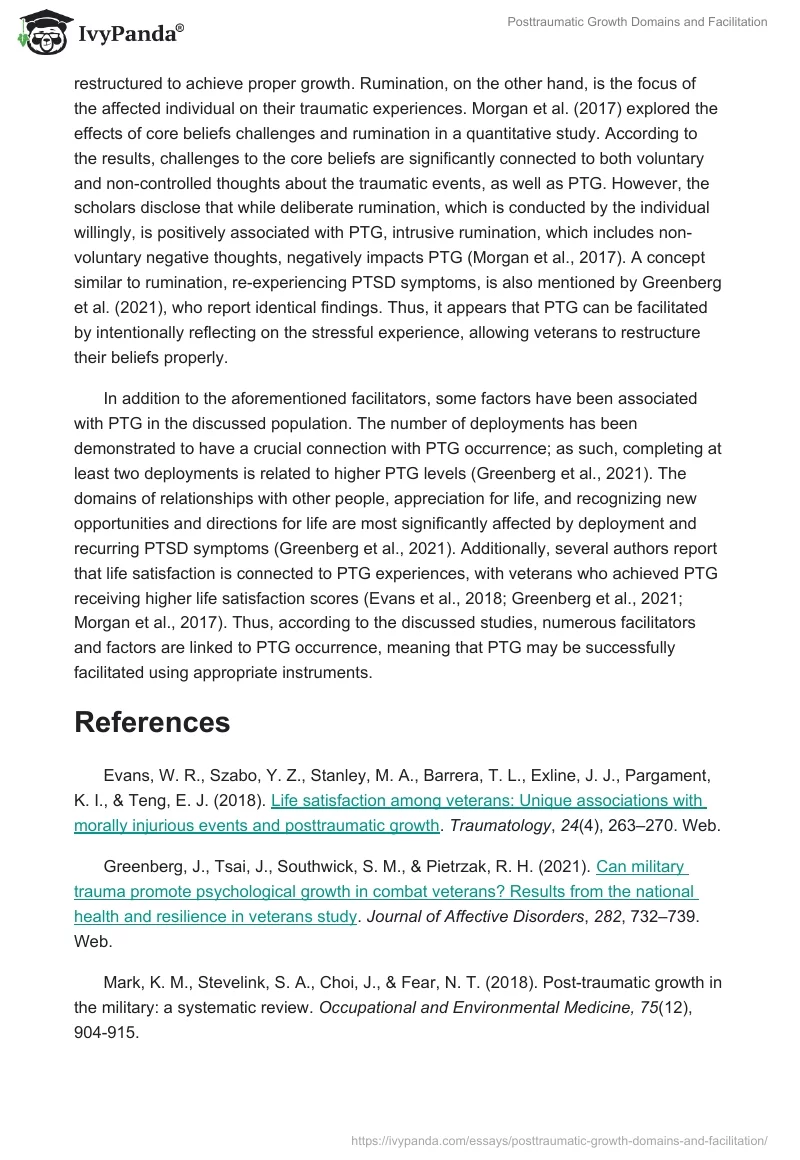The possibility of improving veterans’ psychological well-being through Posttraumatic Growth facilitation (PTG) has been researched by numerous scholars over the course of recent decades. One of the crucial topics was the connection between the five domains of PTG, established by Tedeschi and Calhoun (1996), and the veterans’ experiences in achieving PTG. A longitudinal study on the U.S. military population conducted by Tsai et al. (2016), suggests that the domain of personal strength is associated with the reduced severity and incidence of PTSD symptoms at a two-year follow-up. The authors connect this finding with the possibility that the factor of personal strength is related to the use of various trauma coping strategies, which enhances an individual likelihood of successfully overcoming trauma. The mediating role of the chosen coping style with better PTG outcomes is supported by Mattson et al. (2018), who states that military personnel utilizing the adaptive coping style are achieving higher PTG than those who implemented maladaptive coping. From this perspective, such factors as personal strength and an adaptive coping style can improve the manifestation of PTG in the veteran population.
Adverse trauma has also been shown to lead to higher manifestations of PTG among veterans. Research data from Mark et al. (2018) suggests that military personnel who encountered more severe traumatizing circumstances were more likely to develop PTG. Currently, it is believed that PTG is related to the extent of experienced trauma, meaning that veterans are one of the few populations whose background contributes to the increased likelihood of PTG manifestation (Evans et al., 2018). Greenberg et al. (2021) argue that PTSD symptom severity must be moderate to secure the highest levels of growth in comparison with high and low severity, which do not yield beneficial outcomes. Thus, it appears that, in addition to personal strength and coping style domains, the severity of experienced trauma also plays a critical role in PTG facilitation among military personnel.
A crucial area of PTG investigation in military personnel is connected to core beliefs and rumination. As originally explained by Tedeschi and Calhoun (1996), PTG arises as a result of overcoming the challenge to personal core beliefs, which must be restructured to achieve proper growth. Rumination, on the other hand, is the focus of the affected individual on their traumatic experiences. Morgan et al. (2017) explored the effects of core beliefs challenges and rumination in a quantitative study. According to the results, challenges to the core beliefs are significantly connected to both voluntary and non-controlled thoughts about the traumatic events, as well as PTG. However, the scholars disclose that while deliberate rumination, which is conducted by the individual willingly, is positively associated with PTG, intrusive rumination, which includes non-voluntary negative thoughts, negatively impacts PTG (Morgan et al., 2017). A concept similar to rumination, re-experiencing PTSD symptoms, is also mentioned by Greenberg et al. (2021), who report identical findings. Thus, it appears that PTG can be facilitated by intentionally reflecting on the stressful experience, allowing veterans to restructure their beliefs properly.
In addition to the aforementioned facilitators, some factors have been associated with PTG in the discussed population. The number of deployments has been demonstrated to have a crucial connection with PTG occurrence; as such, completing at least two deployments is related to higher PTG levels (Greenberg et al., 2021). The domains of relationships with other people, appreciation for life, and recognizing new opportunities and directions for life are most significantly affected by deployment and recurring PTSD symptoms (Greenberg et al., 2021). Additionally, several authors report that life satisfaction is connected to PTG experiences, with veterans who achieved PTG receiving higher life satisfaction scores (Evans et al., 2018; Greenberg et al., 2021; Morgan et al., 2017). Thus, according to the discussed studies, numerous facilitators and factors are linked to PTG occurrence, meaning that PTG may be successfully facilitated using appropriate instruments.
References
Evans, W. R., Szabo, Y. Z., Stanley, M. A., Barrera, T. L., Exline, J. J., Pargament, K. I., & Teng, E. J. (2018). Life satisfaction among veterans: Unique associations with morally injurious events and posttraumatic growth. Traumatology, 24(4), 263–270. Web.
Greenberg, J., Tsai, J., Southwick, S. M., & Pietrzak, R. H. (2021). Can military trauma promote psychological growth in combat veterans? Results from the national health and resilience in veterans study. Journal of Affective Disorders, 282, 732–739. Web.
Mark, K. M., Stevelink, S. A., Choi, J., & Fear, N. T. (2018). Post-traumatic growth in the military: a systematic review. Occupational and Environmental Medicine, 75(12), 904-915.
Mattson, E., James, L., & Engdahl, B. (2018). Personality Factors and Their Impact on PTSD and Post-traumatic Growth is Mediated by Coping Style Among OIF/OEF Veterans. Military Medicine, 183(9–10), e475–e480. Web.
Morgan, J. K., Desmarais, S. L., Mitchell, R. E., & Simons-Rudolph, J. M. (2017). Posttraumatic Stress, Posttraumatic Growth, and Satisfaction With Life in Military Veterans. Military Psychology, 29(5), 434–447. Web.
Tedeschi, R. G., & Calhoun, L. G. (1996). The Posttraumatic Growth Inventory: Measuring the positive legacy of trauma. Journal of Traumatic Stress, 9(3), 455-471.
Tsai, J., Mota, N. P., Southwick, S. M., & Pietrzak, R. H. (2016). What doesn’t kill you makes you stronger: A national study of U.S. military veterans. Journal of Affective Disorders, 189, 269–271. Web.


